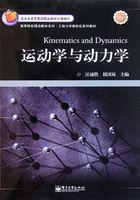
2.2 点的运动方程合成——三种运动方程间的关系
本节分析三种运动——绝对运动、相对运动和牵连运动之间的关系。一般来说,若已知动系运动(即牵连运动)的规律,则可以通过坐标变换来建立点在定系中的坐标(或矢径)与在动系中的坐标(或矢径)的关系。如图2-2所示,定系为O1x1y1z1,沿其坐标轴的单位矢量分别为i1, j1, k1;动系为O2x2y2z2,沿其坐标轴的单位矢量分别为i2, j2, k2。r1为绝对运动的矢径,r2为相对运动的矢径。

图2-2 定系与动系中矢径的关系
由图2-2可知
因为
r1=x1i1+y1j1+z1k1, r2=x2i2+y2j2+z2k2
所以
x1i1+y1j1+z1k1=xO2i1+yO2j1+zO2k1+x2i2+y2j2+z2k2
即
(x1-xO2)i1+(y1-yO2)j1+(z1-zO2)k1=x2i2+y2j2+z2k2
将上式两边依次点乘i1, j1, k1,可得

将上式写成矩阵的形式为

若记

则式(2-1)为

式中,C12称为变换矩阵(transformation matrix)。特殊地,若动系与定系的坐标原点重合,则有

二维情况的简化
对于二维问题,其定系为Oxy,动系为O'x'y',动点为M,如图2-3所示。其变换矩阵为

图2-3 二维情况

若绝对运动方程为
x=x(t), y=y(t)
相对运动方程为
x'=x'(t), y'=y'(t)
牵连运动的方程为
xO'=xO'(t), yO'=yO'(t), φ=φ(t)
则不难得到三种运动方程间的关系为

例题2-1
点M相对于动系Ox'y'沿半径为r的圆周以速度v做匀速圆周运动(圆心为O1),动系Ox'y'相对于定系Oxy以匀角速度ω绕点O做定轴转动,如例题图2-1所示。初始时Ox'y'与Oxy重合,点M与O重合。已知OO 1=r,试求点M的绝对运动方程。

例题图2-1
分析:本题是已知点M的相对运动方程,求点M的绝对运动方程。为此,只要利用式(2-1)写出上述两种运动方程之间的关系即可。
解:
点M的绝对运动方程与相对运动方程满足如下关系:

连接O1M,由图可知: 。于是,得点M的相对运动方程为
。于是,得点M的相对运动方程为

牵连运动的方程为
xO'=xO=0, yO'=yO=0, φ=ωt
利用坐标变换关系式(a),可得点M的绝对运动方程为

例题2-2
用车刀切削工件的端面,车刀刀尖M沿水平轴x做往复运动,如例题图2-2所示。设Oxy为定坐标系,刀尖的运动方程为x=b sinωt。工件以等角速度ω逆时针方向转动。求车刀在工件圆端面上切出的痕迹。

例题图2-2
分析:本题是已知车刀刀尖的绝对运动方程,求刀尖M相对于工件的轨迹方程。
解:
车刀刀尖的绝对运动方程和相对运动方程间的坐标变换关系为

取刀尖M为动点,动系固定在工件上,则动点M在动系Ox'y'和定系Oxy中的坐标关系为

将点M的绝对运动方程(x, y)=(b sinωt, 0)代入式(a)中,得

上式即为车刀相对于工件的运动方程。
从上式中消去时间t,得刀尖的相对运动轨迹方程为

可见,车刀在工件上切出的痕迹是一个半径为 的圆,该圆的圆心C在动坐标轴Oy'上,圆周通过工件的中心O,如例题图2-2中的虚线所示。
的圆,该圆的圆心C在动坐标轴Oy'上,圆周通过工件的中心O,如例题图2-2中的虚线所示。